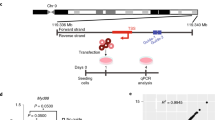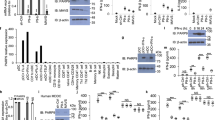Abstract
Short interfering RNA (siRNA) is used in RNA interference technology to avoid non-target-related induction of type I interferon (IFN) typical for long double-stranded RNA. Here we show that in plasmacytoid dendritic cells (PDC), an immune cell subset specialized in the detection of viral nucleic acids and production of type I IFN, some siRNA sequences, independent of their GU content, are potent stimuli of IFN-α production. Localization of the immunostimulatory motif on the sense strand of a potent IFN-α-inducing siRNA allowed dissection of immunostimulation and target silencing. Injection into mice of immunostimulatory siRNA, when complexed with cationic liposomes, induced systemic immune responses in the same range as the TLR9 ligand CpG, including IFN-α in serum and activation of T cells and dendritic cells in spleen. Immunostimulation by siRNA was absent in TLR7-deficient mice. Thus sequence-specific TLR7-dependent immune recognition in PDC needs to be considered as an additional biological activity of siRNA, which then should be termed immunostimulatory RNA (isRNA).
This is a preview of subscription content, access via your institution
Access options
Subscribe to this journal
Receive 12 print issues and online access
$209.00 per year
only $17.42 per issue
Buy this article
- Purchase on SpringerLink
- Instant access to full article PDF
Prices may be subject to local taxes which are calculated during checkout





Similar content being viewed by others
References
Novina, C.D. & Sharp, P.A. The RNAi revolution. Nature 430, 161–164 (2004).
Hammond, S.M., Bernstein, E., Beach, D. & Hannon, G.J. An RNA-directed nuclease mediates post-transcriptional gene silencing in Drosophila cells. Nature 404, 293–296 (2000).
Zamore, P.D., Tuschl, T., Sharp, P.A. & Bartel, D.P. RNAi: double-stranded RNA directs the ATP-dependent cleavage of mRNA at 21 to 23 nucleotide intervals. Cell 101, 25–33 (2000).
Tuschl, T. & Borkhardt, A. Small interfering RNAs: a revolutionary tool for the analysis of gene function and gene therapy. Mol. Interv. 2, 158–167 (2002).
Ahlquist, P. RNA-dependent RNA polymerases, viruses, and RNA silencing. Science 296, 1270–1273 (2002).
Plasterk, R.H. RNA silencing: the genome's immune system. Science 296, 1263–1265 (2002).
Elbashir, S.M. et al. Duplexes of 21-nucleotide RNAs mediate RNA interference in cultured mammalian cells. Nature 411, 494–498 (2001).
Bitko, V. & Barik, S. Phenotypic silencing of cytoplasmic genes using sequence-specific double-stranded short interfering RNA and its application in the reverse genetics of wild type negative-strand RNA viruses. BMC Microbiol. 1, 34 (2001).
Williams, B.R. Signal integration via PKR. Sci. STKE 89, RE2 (2001).
Meurs, E.F. et al. Constitutive expression of human double-stranded RNA-activated p68 kinase in murine cells mediates phosphorylation of eukaryotic initiation factor 2 and partial resistance to encephalomyocarditis virus growth. J. Virol. 66, 5805–5814 (1992).
Katze, M.G. et al. Functional expression and RNA binding analysis of the interferon-induced, double-stranded RNA-activated, 68,000-Mr protein kinase in a cell-free system. Mol. Cell. Biol. 11, 5497–5505 (1991).
Alexopoulou, L., Holt, A.C., Medzhitov, R. & Flavell, R.A. Recognition of double-stranded RNA and activation of NF-kappaB by Toll-like receptor 3. Nature 413, 732–738 (2001).
Takeda, K., Kaisho, T. & Akira, S. Toll-like receptors. Annu. Rev. Immunol. 21, 335–376 (2003).
Krieg, A.M. et al. CpG motifs in bacterial DNA trigger direct B-cell activation. Nature 374, 546–549 (1995).
Lund, J., Sato, A., Akira, S., Medzhitov, R. & Iwasaki, A. Toll-like receptor 9–mediated recognition of herpes simplex virus-2 by plasmacytoid dendritic cells. J. Exp. Med. 198, 513–520 (2003).
Krug, A. et al. Herpes simplex virus type 1 activates murine natural interferon-producing cells through toll-like receptor 9. Blood 103, 1433–1437 (2004).
Hemmi, H. et al. A Toll-like receptor recognizes bacterial DNA. Nature 408, 740–745 (2000).
Bauer, S. et al. Human TLR9 confers responsiveness to bacterial DNA via species-specific CpG motif recognition. Proc. Natl. Acad. Sci. USA 98, 9237–9242 (2001).
Latz, E. et al. TLR9 signals after translocating from the ER to CpG DNA in the lysosome. Nat. Immunol. 5, 190–198 (2004).
Diebold, S.S., Kaisho, T., Hemmi, H., Akira, S. & Reis e Sousa, C. Innate antiviral responses by means of TLR7-mediated recognition of single-stranded RNA. Science 303, 1529–1531 (2004).
Heil, F. et al. Species-specific recognition of single-stranded RNA via toll-like receptor 7 and 8. Science 303, 1526–1529 (2004).
Heil, F. et al. The Toll-like receptor 7 (TLR7)-specific stimulus loxoribine uncovers a strong relationship within the TLR7, 8 and 9 subfamily. Eur. J. Immunol. 33, 2987–2997 (2003).
Lee, J. et al. Molecular basis for the immunostimulatory activity of guanine nucleoside analogs: activation of Toll-like receptor 7. Proc. Natl. Acad. Sci. USA 100, 6646–6651 (2003).
Hornung, V. et al. Replication-dependent potent IFN-alpha induction in human plasmacytoid dendritic cells by a single-stranded RNA virus. J. Immunol. 173, 5935–5943 (2004).
Krug, A. et al. Toll-like receptor expression reveals CpG DNA as a unique microbial stimulus for plasmacytoid dendritic cells which synergizes with CD40 ligand to induce high amounts of IL-12. Eur. J. Immunol. 31, 3026–3037 (2001).
Hornung, V. et al. Quantitative expression of toll-like receptor 1-10 mRNA in cellular subsets of human peripheral blood mononuclear cells and sensitivity to CpG oligodeoxynucleotides. J. Immunol. 168, 4531–4537 (2002).
Elbashir, S.M., Lendeckel, W. & Tuschl, T. RNA interference is mediated by 21- and 22-nucleotide RNAs. Genes Dev. 15, 188–200 (2001).
Hartmann, G. & Krieg, A.M. Mechanism and function of a newly identified CpG DNA motif in human primary B cells. J. Immunol. 164, 944–953 (2000).
Lund, J.M. et al. Recognition of single-stranded RNA viruses by Toll-like receptor 7. Proc. Natl. Acad. Sci. USA 101, 5598–5603 (2004).
Krug, A. et al. CpG-A oligonucleotides induce a monocyte-derived dendritic cell-like phenotype that preferentially activates CD8 T cells. J. Immunol. 170, 3468–3477 (2003).
Rothenfusser, S. et al. CpG-A and CpG-B oligonucleotides differentially enhance human peptide-specific primary and memory CD8+ T-cell responses in vitro. Blood 103, 2162–2169 (2004).
Poeck, H. et al. Plasmacytoid dendritic cells, antigen, and CpG-C license human B cells for plasma cell differentiation and immunoglobulin production in the absence of T-cell help. Blood 103, 3058–3064 (2004).
Dittmer, U. & Olbrich, A.R. Treatment of infectious diseases with immunostimulatory oligodeoxynucleotides containing CpG motifs. Curr. Opin. Microbiol. 6, 472–477 (2003).
Krieg, A.M. CpG motifs: the active ingredient in bacterial extracts? Nat. Med. 9, 831–835 (2003).
Heckelsmiller, K. et al. Combined dendritic cell- and CpG oligonucleotide-based immune therapy cures large murine tumors that resist chemotherapy. Eur. J. Immunol. 32, 3235–3245 (2002).
Heckelsmiller, K. et al. Peritumoral CpG DNA elicits a coordinated response of CD8 T cells and innate effectors to cure established tumors in a murine colon carcinoma model. J. Immunol. 169, 3892–3899 (2002).
Hartmann, E. et al. Identification and functional analysis of tumor-infiltrating plasmacytoid dendritic cells in head and neck cancer. Cancer Res. 63, 6478–6487 (2003).
Weiner, G.J. CpG DNA in cancer immunotherapy. Curr. Top. Microbiol. Immunol. 247, 157–170 (2000).
Klein, C. et al. Inhibition of hepatitis B virus replication in vivo by nucleoside analogues and siRNA. Gastroenterology 125, 9–18 (2003).
Davidson, B.L. Hepatic diseases--hitting the target with inhibitory RNAs. N. Engl. J. Med. 349, 2357–2359 (2003).
Sledz, C.A., Holko, M., de Veer, M.J., Silverman, R.H. & Williams, B.R. Activation of the interferon system by short-interfering RNAs. Nat. Cell Biol. 5, 834–839 (2003).
Kariko, K., Bhuyan, P., Capodici, J. & Weissman, D. Small interfering RNAs mediate sequence-independent gene suppression and induce immune activation by signaling through toll-like receptor 3. J. Immunol. 172, 6545–6549 (2004).
Kariko, K. et al. Exogenous siRNA mediates sequence-independent gene suppression by signaling through toll-like receptor 3. Cells Tissues Organs 177, 132–138 (2004).
Hoebe, K. et al. Upregulation of costimulatory molecules induced by lipopolysaccharide and double-stranded RNA occurs by Trif-dependent and Trif-independent pathways. Nat. Immunol. 4, 1223–1229 (2003).
Kim, D.H. et al. Interferon induction by siRNAs and ssRNAs synthesized by phage polymerase. Nat. Biotechnol. 22, 321–325 (2004).
Spies, B. et al. Vaccination with plasmid DNA activates dendritic cells via Toll-like receptor 9 (TLR9) but functions in TLR9-deficient mice. J. Immunol. 171, 5908–5912 (2003).
Krug, A. et al. Identification of CpG oligonucleotide sequences with high induction of IFN-alpha/beta in plasmacytoid dendritic cells. Eur. J. Immunol. 31, 2154–2163 (2001).
Acknowledgements
This study was supported by research funding from the Deutsche Forschungsgemeinschaft (DFG) Ha 2780/4-1 and the Sonderforschungsbereich (SFB) 571, from the Bundesministerium für Bildung und Forschung (BMBF, Biofuture 0311896) and from the Human Science Foundation of Japan to G.H. and from DFG En 169/7-1 to S.E. This work is part of the dissertations of M. Guenthner-Biller and of A. Ablasser at the Ludwig-Maximilians-University, Munich, Germany. Lastly, the authors would like to acknowledge R. Meyers for her assistance.
Author information
Authors and Affiliations
Corresponding author
Ethics declarations
Competing interests
Anne Noronha, Muthiah Manoharan and Antonin dr Fougerolles are employees of Alnylam Pharmaceuticals, Cambridge.
Supplementary information
Supplementary Fig. 1
PDC produce IFN-α in response to TLR7 and TLR9 ligands but not upon transfection with long dsRNA. (PDF 54 kb)
Supplementary Fig. 2
Induction of IFN-α in plasmacytoid dendritic cells by siRNA is dose dependent and can be achieved by delivery of siRNA via cationic lipids or electroporation. (PDF 123 kb)
Supplementary Table 1
siRNA sequences (PDF 23 kb)
Rights and permissions
About this article
Cite this article
Hornung, V., Guenthner-Biller, M., Bourquin, C. et al. Sequence-specific potent induction of IFN-α by short interfering RNA in plasmacytoid dendritic cells through TLR7. Nat Med 11, 263–270 (2005). https://doi.org/10.1038/nm1191
Received:
Accepted:
Published:
Issue Date:
DOI: https://doi.org/10.1038/nm1191



